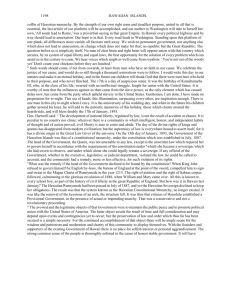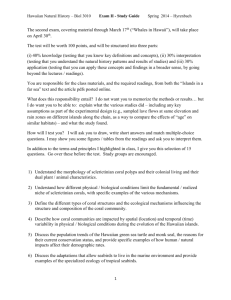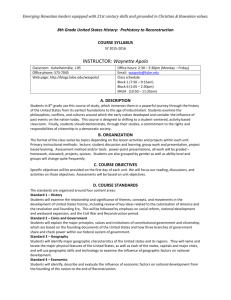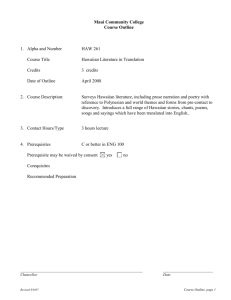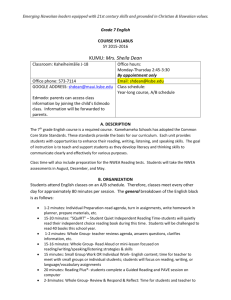a brief history of the design evolution
advertisement
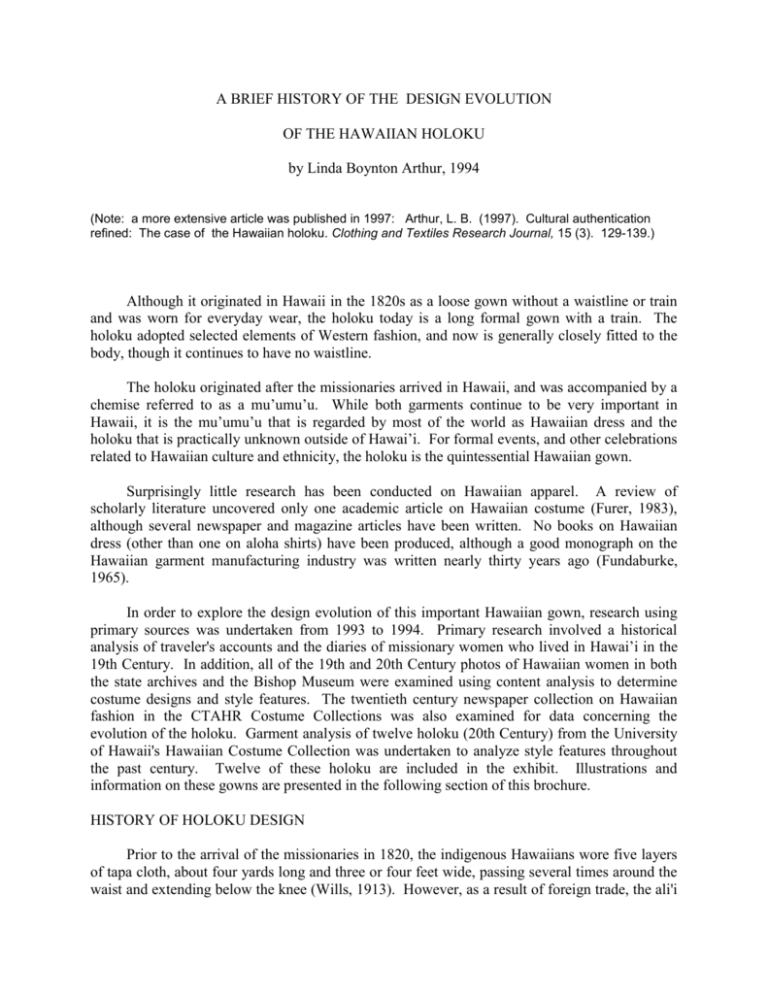
A BRIEF HISTORY OF THE DESIGN EVOLUTION OF THE HAWAIIAN HOLOKU by Linda Boynton Arthur, 1994 (Note: a more extensive article was published in 1997: Arthur, L. B. (1997). Cultural authentication refined: The case of the Hawaiian holoku. Clothing and Textiles Research Journal, 15 (3). 129-139.) Although it originated in Hawaii in the 1820s as a loose gown without a waistline or train and was worn for everyday wear, the holoku today is a long formal gown with a train. The holoku adopted selected elements of Western fashion, and now is generally closely fitted to the body, though it continues to have no waistline. The holoku originated after the missionaries arrived in Hawaii, and was accompanied by a chemise referred to as a mu’umu’u. While both garments continue to be very important in Hawaii, it is the mu’umu’u that is regarded by most of the world as Hawaiian dress and the holoku that is practically unknown outside of Hawai’i. For formal events, and other celebrations related to Hawaiian culture and ethnicity, the holoku is the quintessential Hawaiian gown. Surprisingly little research has been conducted on Hawaiian apparel. A review of scholarly literature uncovered only one academic article on Hawaiian costume (Furer, 1983), although several newspaper and magazine articles have been written. No books on Hawaiian dress (other than one on aloha shirts) have been produced, although a good monograph on the Hawaiian garment manufacturing industry was written nearly thirty years ago (Fundaburke, 1965). In order to explore the design evolution of this important Hawaiian gown, research using primary sources was undertaken from 1993 to 1994. Primary research involved a historical analysis of traveler's accounts and the diaries of missionary women who lived in Hawai’i in the 19th Century. In addition, all of the 19th and 20th Century photos of Hawaiian women in both the state archives and the Bishop Museum were examined using content analysis to determine costume designs and style features. The twentieth century newspaper collection on Hawaiian fashion in the CTAHR Costume Collections was also examined for data concerning the evolution of the holoku. Garment analysis of twelve holoku (20th Century) from the University of Hawaii's Hawaiian Costume Collection was undertaken to analyze style features throughout the past century. Twelve of these holoku are included in the exhibit. Illustrations and information on these gowns are presented in the following section of this brochure. HISTORY OF HOLOKU DESIGN Prior to the arrival of the missionaries in 1820, the indigenous Hawaiians wore five layers of tapa cloth, about four yards long and three or four feet wide, passing several times around the waist and extending below the knee (Wills, 1913). However, as a result of foreign trade, the ali'i (Hawaiian royalty) eagerly acquired and wore items of Western dress and traded for fabric; the queens had amassed a large store of yardage prior to the arrival of the Christian missionaries in 1820. When the ship Thaddeus arrived, the missionary women were wearing the Western fashion of the day -- dresses with a short waist, narrow skirt and long, tight sleeves. Queen Kamamalu and her retinue were enchanted and immediately requested that dresses be sewn for them. The queens brought out their stores of brocades, silks and chintz, and the decks of the Thaddeus were immediately transformed into a sewing school (Hawaiian Gazette, 1907). The missionaries adapted their highwaisted style to fit the size of the women, and to adapt to the hot, humid environment (Fundaburke, 1965; Hawaiian Gazette, 1907). Diaries of the missionaries report that the Ali'i were people of "noble stature". While the commoners varied in size, the queens reportedly weighed 300 pounds. In order to produce a more becoming line, the missionary women replaced the high waistline of Western fashion with an above the bust yoke (Furer, 1983; Fundaburke, 1965). The end result was a basic design (referred to as a "Mother Hubbard") which was simply a full, straight skirt attached to a yoke with a high neck and tight sleeves. The holoku was quickly adopted, due in large part, to its comfort. The missionaries established women's societies that advanced the notion of modesty. The diaries of missionary women report that Hawaiian women who had been Christianized adopted the holoku as daily dress by 1822 (Thurston, 1882) and it became standard dress of all Hawaiian women as early as 1838 (Thurston, 1842). Various tales place the naming of the garment very early in its creation. The term holoku was created from two Hawaiian words, holo meaning to go, and ku meaning to stop. Wearing the garment for the first time, the Hawaiian women are reported to have said "Holo! Ku!" Very roughly translated, this means "We can run in it -- we can stand!" (Development of the Holoku, 1950). The more commonly cited explanation for the term comes from the following legend which relies on a more exact translation of the Hawaiian words. Native seamstresses, when sewing their dresses, would say "holo!" (run) as they turned the wheel to operate the sewing machine, and "ku" (stop) when they wished to stop at the end of a seam. Consequently, these two words were connected and the term is explained (Hussey, 1940). The comfort of the holoku was note by Isabella Lucy Bird, who traveled through the Hawaiian Islands in 1873. She described the holoku in great detail, praised its beauty, simplicity and comfort. In contrast to the confinement of Western fashion, Bird noted that "if we white women always wore holoku of one shape, we should have fewer gloomy moments." (1882, p.150). After the mid 1800's, The royal courts of Kings Kamehameha III and IV and their queens, Kalama and Emma were intimately connected to European royalty, and that influence was seen in the fashions worn by the ali’i. For court functions, Hawaiian queens and princesses wore the height of European fashions, created by the noted couturiers of the day. However, for informal occasions, queens and princesses wore holoku. From 1820 to 1890, the holoku, previously referred to as a Mother Hubbard, was the dominant style, but due to the influence of European styles after 1850, the holoku began to lose some of its fullness. By 1873, the holoku was considered "native dress", and worn by nearly all Hawaiian women. European fashion was worn by haoles (foreigners) (Bird, 1873). The loose Mother Hubbard style, both plain and with assorted trimmings and trains continued to be the dominant style until 1890, at which time it became a secondary, traditional style. (It continues to be worn today). In the 1890s, a new style which I refer to as the "fashion holoku" emerged. This holoku reflected prevailing trends in Western fashion. In particular, it utilized the princess line to become closer fitting, and incorporated a variety of sleeves and sweeping trains. Laces, eyelets, ruffles and trims were added, and lower necklines were introduced. From 1900 through 1920, the Mother Hubbard continued to be worn with no significant change, while the fashion holoku had a great deal more detail; it greatly resembled the European tea gown. Both types were full rather than fitted. These holoku were made in lawn, batiste and dimity, and had a straighter silhouette than previously. Trains lengthened, and the use of lace, eyelet, pin tucks and ruffles at the sleeves, yokes and hems increased significantly. Until the 1920s, holoku were generally long dresses with a yoke, long sleeves and a train; they were either very full and plain (Mother Hubbard style) or slender fitting with a great deal of embellishment (fashion holoku). However, from the 1920s to the 1930s, there were dramatic changes in the fashion holoku. Using the princess line and bias cuts (and zippers by 1933) the holoku became very fitted, and often eliminated yokes. Necklines were lowered, trains became quite long (up to six feet) and sleeves were shortened or eliminated altogether. Ruffles, especially those resembling a lei, were dominant. From the mid 1930s through the 1950s, the design of the fashion holoku continued to be fitted, with a long train. The use of very bold Hawaiian prints became common, in response to the importance of tourism and the Hawaiian garment industry. Fabric used in the holoku became more sedate after the 1960s and prints have become uncommon. Typically, laces, satins, velvets, silks and other formal dress fabrics are used, and the holoku has continually become more fitted while trains have reduced to a negligible size. At present, the fashion holoku continues to be fitted to the body, with design details closely following Western fashion. Trains vary in length, depending on the formality of the occasion. While the fashion holoku is dominant, the more traditional holoku continues to be worn, often by more traditional, mature women. As long as the holoku is associated with Hawaiian tradition, it will continue to be worn as a symbol of the wearer's commitment to Hawaiian culture. REFERENCES CITED Bird, I.A. (1882). Six Months in the Sandwich Islands. New York. Putnam. Development of the Holoku. (1950). Paradise of the Pacific. 12-13. Fundaburke, E. (1965). The Garment Manufacturing Industry of Hawaii. Economic Research Center, Honolulu, HI. Furer, G. (1983). Designs of Hawaiian wear. ACPTC COMBINED PROCEEDINGS. 13-20. Holoku -- its origin and evolution. (1907). Picturesque Honolulu. 44-45. Hussey, W. K. (1940, June 9). Holoku: Hawaii's glamour gown. Honolulu Advertiser. Magazine Section. 1. Thurston, L. G. (1842). The Missionary's Daughter or Memoirs of Lucy Goodale Thurston of the Sandwich Islands. New York. Dayton & Newman. Thurston, L. G. (1882). Life and times of Mrs. Lucy G. Thurston. Ann Arbor. Wills, F. H. (1913, May). The story of the holoku. Mid Pacific Magazine. 465-467.
